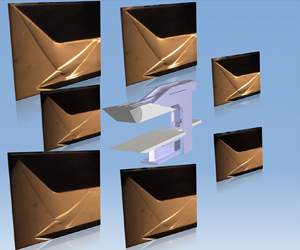Published online by Cambridge University Press: 01 June 2021

In this paper, the incident shock–separation shock interactions on a surface plate near the leading edge are studied theoretically and experimentally, and the transition from regular reflection (RR) to Mach reflection (MR) is the main focus. The theoretical method employs free interaction theory (FIT) and the minimum entropy production (MEP) principle to analyse the separation shock strength of flow separated from the boundary layer and separated from the leading edge, respectively, the criterion based on the MEP principle is employed to predict the RR-to-MR transition near the leading edge. The experiments were performed on a rotatable wedge situated over a sharp leading-edge plate such that the wedge could continuously change the flow deflection angle from  $0^{\circ }$ to
$0^{\circ }$ to  $40^{\circ }$ by means of a high-precision control device. Fast-response transducers and a high-speed camera were used to measure dynamic pressures and to take schlieren images, respectively. The influences of wedge positions, Reynolds numbers and Mach numbers on shock reflections are investigated by careful tests. The theoretical and experimental results for Mach numbers 5, 6, 7 and 8 show good agreement, indicating that the theoretical method is applicable.
$40^{\circ }$ by means of a high-precision control device. Fast-response transducers and a high-speed camera were used to measure dynamic pressures and to take schlieren images, respectively. The influences of wedge positions, Reynolds numbers and Mach numbers on shock reflections are investigated by careful tests. The theoretical and experimental results for Mach numbers 5, 6, 7 and 8 show good agreement, indicating that the theoretical method is applicable.